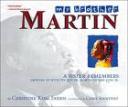My Brother Martin, written by Christine King Farris and beautifully illustrated by Chris Soentpiet tells the story of Martin Luther King, Jr. through the eyes of his sister Christine.
In this book we learn about the boyhood of King, known to his sister as “ML”. The author tells us that she and her brothers ML, and AD grew up in Atlanta, Georgia just like normal children. Their days were filled with books, games, friends, and even playing pranks on unsuspecting neighbors. However, she tells us that this was “back in a time when certain places in our country had unfair laws that said it was right to keep black people separated.” ML and his siblings didn’t quite understand the effects of these laws until one day their white playmates were no longer allowed to play with them. Martin is especially confused by what is happening and asks his mother, “Why do white people treat colored people so mean?” His mother answers, “Because they just don’t understand that everyone is the same, but someday, it will be better.” The author tells us that she will always remember ML’s reply, “one day I’m going to turn this world upside down.” The story then continues to tell how ML grew up to become a civil rights leader who “dreamed a dream, that turned the world upside down.”
Curriculum Connections
This book would pair well with any lesson about the contributions of Martin Luther King, Jr. It could be used for students who are learning about Americans whose contributions improved the lives of others (SOL 2.11, SOL 3.11), as well as the theme that Americans are a people of diverse ethnic origins, customs, and traditions, who are united by the basic principles of a republican form of government and respect for individual rights and freedoms (SOL 3.12).
Additional Resources
- This lesson plan has a lot of ideas for discussion about King as well as classroom activities.
- Little books, quizzes and coloring pages about Martin Luther King, Jr. and civil rights.
- A Read Write Think lesson plan that incorporates the book.
Author: Christine King Farris
Illustrator: Chris Soentpiet
Publisher: Aladdin
Publication Date: 2005
Pages: 40
Grade Range: 2-4
ISBN: 978-0689843884

